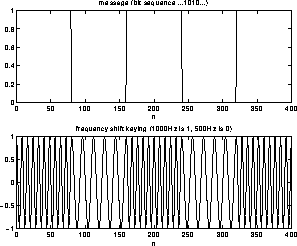
Figure 9: Frequency Shift Keying
In these schemes either the frequency or phase of a carrier signal is keyed in response to patterns of 1s and 0s. Of course one could also key the amplitude, but this is what we already called PAM. Frequency Shift Keying (FSK) stands for the process of keying between two different frequencies as shown in figure 9.

Figure 9: Frequency Shift Keying
As in the case of PAM, we can group the bits and then do frequency shift keying and this is referred to as QFSK or 4-FSK, 8-FSK, etc. For example the full duplex ``dinosaur'' 300 baud modems use 2-FSK (1070 Hz for a 0 send, 1270 Hz for a 1 send; 2025 Hz for a 0 receive and 2225 Hz for a 1 receive).
Phase Shift Keying (PSK) is a technique for switching phases in response to the signal. As before we have quadrature versions of PSK which are referred to as either QPSK or 4-PSK, 8-PSK, etc. The 1200 Baud full duplex, 2400 Baud full duplex and 4800 baud full duplex modems use 4-PSK or 8-PSK. An example of PSK is shown in Figure 10.
In channels where there is rapid fading such as mobile radio (wireless) channels it is useful to use PSK modulation, since the decoder does not need to keep track of the intensity of the received signal. For greater noise immunity in these applications, one uses a so-called differential modulation scheme, where one encodes the changes in the group of bits being encoded. Thus, for example digital cellular radio in North America uses a so-called differential PSK-4 (DPSK-4) scheme.